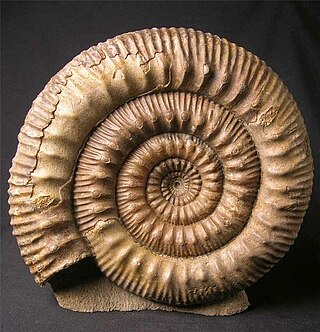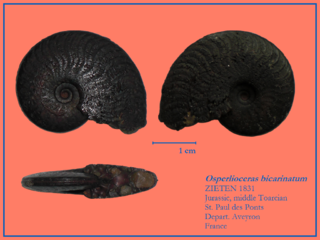
Dactylioceras was a widespread genus of ammonites from the Lower Jurassic period, approximately 180 million years ago (mya).
The Toarcian is, in the ICS' geologic timescale, an age and stage in the Early or Lower Jurassic. It spans the time between 184.2 Ma and 174.7 ±0.8 Ma. It follows the Pliensbachian and is followed by the Aalenian.

The Aalenian is a subdivision of the Middle Jurassic Epoch/Series of the geologic timescale that extends from about 174.7 ±0.8 Ma to about 170.9 ±0.8 Ma. It was preceded by the Toarcian and succeeded by the Bajocian.

Stenopterygius is an extinct genus of thunnosaur ichthyosaur known from Europe.

Stephanoceras is an extinct genus of Stephanoceratoid ammonite which lived during the Bajocian. It is the type genus of the family Stephanoceratidae.

Echioceras is an extinct genus of ammonites from the Early Jurassic of Europe and North America.

Normannites is a strongly ribbed evolute Middle Jurassic genus of ammonite included in the stephanoceratoid family Stephanoceratidae.

Peltoceras is an extinct ammonite genus from the aspidoceratid subfamily Peltoceratinae that lived during the later part of the Middle Jurassic.

Lobolytoceras is an extinct genus of ammonite in which only the inner whorls have large swollen ribs, later whorls have wrinkled growth lines which coarsen somewhat, near the aperture. The genus is known from the Lower Jurassic Toarcian of Europe. The type species L. siemensi (Denck) came from the Upper Toarcian of Germany.

Hammatoceras is a genus of ammonites belonging to the family Hammatoceratidae which lived during the Toarcian stage of the Early/Lower Jurassic between about 184 and 175 million year ago.
Ovaticeras is an extinct genus of cephalopod belonging to the family Hildoceratidae. These cephalopods existed in the Jurassic period, during upper Pliensbachian and lower Toarcian. Its fossils were found in Europe, North Africa and possibly also in Canada and Vietnam. It might have evolved from Harpoceras falciferum and died out without leaving any descendants.

Osperleioceras is an extinct genus of cephalopod belonging to the family Hildoceratidae. These cephalopods existed in the Jurassic period, during Toarcian stage. Its fossils were found in Europe and South America. First species of this genus, Osperleioceras bicarinatum has evolved in what is now France from Harpoceras subplanatum.

Cleviceras is an extinct genus of cephalopod belonging to the family Hildoceratidae. These cephalopods existed in the Jurassic period, during Toarcian and possibly even uppermost Pliensbachian age. Sometimes, it is considered to be a synonym of Eleganticeras.
Radstockiceras is an extinct genus of lower Jurassic ammonite that lived from Oxynotum zone of upper Sinemurian to Raricostatum zone of lower Pliensbachian. Shells of these animals were oxycone and involute with umbilicus that took maximum of 12% of diameter in the case of outer whorls. On inner whorls, venter has been sharp, but then it became rounded. Faint ribs had falcoid shape, but sometimes, ribs could absent. Shells could have been large in their size. Suture has been very complex, similar to Oxynoticeras, but culmination at umbilical margin has been missing. Genus has been named after town of Radstock, in Somerset.
Reynesocoeloceras is genus of ammonite that lived during the lower Pliensbachian stage of early Jurassic, ammonite zones Ibex—Davoei.
Peronoceras is genus of ammonite that lived during the middle Toarcian stage of early Jurassic. Members of this genus existed only in Fibulatum Subzone of Bifrons Zone. Their fossils were found in Europe, northern Africa, Asia, North America and South America.
Porpoceras is genus of ammonite that lived during the early and middle Toarcian stage of early Jurassic. Members of this genus existed from uppermost part of the Harpoceras serpentinum zone to the Haugia variabilis zone. Their fossils were found in Europe, Asia, North America and South America.

Catacoeloceras is a genus of ammonite that lived during Middle Toarcian stage of early Jurassic. Members of this genus existed from the Bifrons Subzone of the Bifrons Zone to the Variabilis Zone. Their fossils have been found in Europe, northern Africa, Asia, North America and South America. It is believed to have evolved from Porpoceras.
Nodicoeloceras is genus of ammonite that lived during early to middle Toarcian stage of early Jurassic. Members of this genus existed from Exaratum Subzone of Falciferum Zone to Commune subzone of Bifrons Zone. Their fossils were found in Europe, northern Africa, Asia, North America and South America. It has probably evolved from Dactylioceras (Orthodactylites) or Kedonoceras and gave rise to Mesodactylites.

Orthildaites is a genus of ammonites that lived during the lower Toarcian stage of early Jurassic, during Falciferum subzone.














